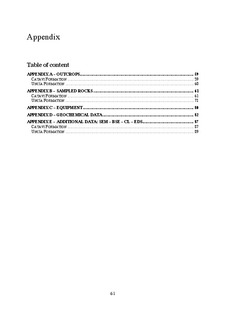| dc.contributor.author | Hatløy, Sveinung | |
| dc.date.accessioned | 2013-11-14T09:22:57Z | |
| dc.date.available | 2013-11-14T09:22:57Z | |
| dc.date.issued | 2013-06-14 | |
| dc.identifier.uri | http://hdl.handle.net/11250/183492 | |
| dc.description | Master's thesis in Petroleum Geoscience engineering | no_NO |
| dc.description.abstract | Two formations, Catavi and Uncía, comprise sedimentary rocks from Llandovery to possibly latest Pridoli rocks deposited in the Eastern Cordillera, northeast of La Paz. The main lithologies for the Uncía Formation are marine pelitic sediments with gradually more frequent arenaceous interbedding toward its top, where it meets the conformable Catavi Formation. Deposited during the Pridoli the Catavi Formation consists of interbedding of sand and shale deposited in a shallow shelf environment. Catavi and Uncía Formation lies in direct stratigraphic relationship to the diamictite bearing Cancañiri Formation consisting of post-glacial black shales deposited during Late Ordocivian along the Gondwana margin. Therefor a study focusing on composition using quantitative and petrological tools is ideal to determine their provenance, source and paleohistory. The provenance of the Uncía Formation points to a source or sources very close to the depositional areas as sorting effects did not
play a role: shales and sands have the same trace element signature. Abundant pyrite, v
even rounded grains in the heavy mineral fraction let assume an environment with low abundance of oxygen. However, organic matter is not anymore or has never been preserved. As the sandstones of this formation contain a variety of arc-related geochemical proxies one source might have been a Mid Ordovician succession, not anymore exposed or covered, in proximity, and the underlying pyrite-rich Cancaniri Formation (Mehus, 2013). The depositional environment changes towards the younger rocks (the Catavi Formation), with less preserved pyrite and even less organic carbon. The sources for this formation might have been more variable but point to longer transportation of the grains.
The lack of any characteristics for larger organic matter, with even absence of common graptolites in the shales, point to a deposition under partly anoxic conditions but without abundant organic matter. Hence, it seems that the post-Hirnantian faunas did not recover until the Uncía Formation in contradiction to northern Gondwana successions, today deposited in Europe where Silurian rocks are rich in organic matter. This implies for Bolivia that hydrocarbon reservoirs have been sourced from other rocks. | no_NO |
| dc.language.iso | eng | no_NO |
| dc.publisher | University of Stavanger, Norway | no_NO |
| dc.relation.ispartofseries | Masteroppgave/UIS-TN-IPT/2013; | |
| dc.subject | petroleumsgeologi | no_NO |
| dc.subject | sedimentology | no_NO |
| dc.subject | reservoir characterization | no_NO |
| dc.subject | heavy minerals | no_NO |
| dc.subject | petrography | no_NO |
| dc.subject | provenance | no_NO |
| dc.subject | Bolivia | no_NO |
| dc.subject | Catavi | no_NO |
| dc.subject | Uncía | no_NO |
| dc.subject | petroleum geoscience engineering | no_NO |
| dc.title | From cold to hot: post- Hirnantian sedimentary basins in Bolivia- A source rock for hydrocarbon deposits in the Andes? – A case study of the Uncía and Catavi formations. | no_NO |
| dc.type | Master thesis | no_NO |
| dc.subject.nsi | VDP::Technology: 500::Rock and petroleum disciplines: 510::Geological engineering: 513 | no_NO |

